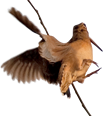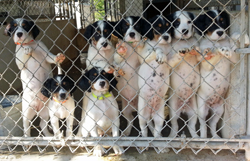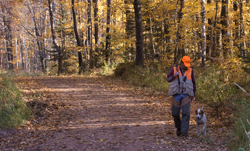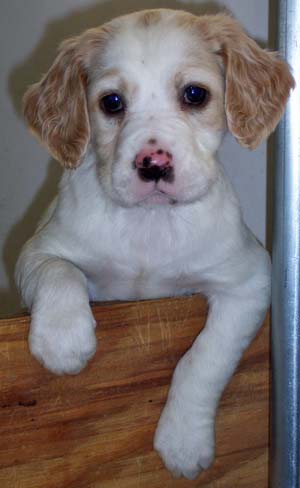Early development of puppies
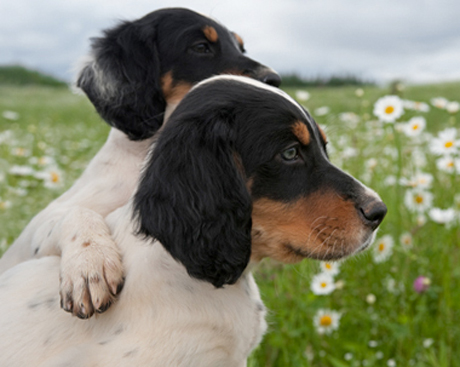
Northwoods Roquefort, on left, and Northwoods Parmigiano (Northwoods Blue Ox x Houston’s Belle’s Choice, 2010). Photo by Chris Mathan.
The overall goal of any dog breeder should be to produce healthy, happy, well-adjusted puppies.
The further objective for a breeder of bird dogs that will be in the field as hunters or field trial competitors should be to produce dogs that travel well, handle stress and pressure, take training well and perform with confidence and style.
At Northwoods Bird Dogs, a final, crucial goal is to breed pointers and setters that are as good in the home as in the field. Jerry and I strive for puppies that have it all—including intelligence and temperament.
But more than good genes are needed; early development of puppies is essential.
We’ve found that there are five factors vital to early development of puppies. Some of these practices help foster a good attitude that will make them a better dog in general. Others actually begin the very earliest stages of training—even before the puppy is aware it’s being trained.
And it all starts when the puppies are at their very tiniest.
Health of the dam.
This is so important! Jerry and I believe the dam is key. Not only is her stamina and demeanor integral for whelping, but puppies are completely dependent on her from birth to at least three weeks.
Special attention should start as soon as she’s bred. Nutrition is essential and only premium quality food should be fed. We gradually increase her daily ration with a watchful eye on her weight. Her caloric intake will peak when she is nursing and will need about twice her normal amount.
The dam should be in excellent physical condition prior to whelping. She should have daily exercise with obvious care as she gains weight.
More subtle, perhaps, but equally influential is the dam’s temperament. Even before birth, puppies are influenced by her and they continue to interact with her until completely weaned at about six weeks. For example, puppies will key off her attitude toward people.
Super Puppy.
Several years ago Jerry discovered a program that was developed by the U.S. military to improve performance of their canine units. They named it Bio Senser which later became known as Super Dog. We call it Super Puppy.
According to Dr. Carmen L. Battaglia, author and researcher, the military’s study showed that “early neurological stimulation exercises could have important and lasting effects” on the dog’s brain in terms of ability to cope, adjust and adapt to situations. The study discovered that Day 3 until Day 16 “is a period of rapid neurological growth and development.”
The benefits are numerous:
• improved heart rate
• stronger heart beats
• stronger adrenal glands
• more calm and less disturbed when stressed
• greater resistance to disease
• mature faster
• better problem solving
• more active
• more exploratory
Super Puppy is a series of five exercises. For every litter, Jerry or Dan pick up each puppy individually and perform the exercises.
Environment.
We whelp and raise litters in runs adjacent to our own and other dogs. From the moment our puppies are born, they are subjected to various noises of differing intensities—whether melodious voices on National Public Radio or near-deafening cacophony of 20 hungry dogs at feeding time.
Ours is a working kennel with lots of daily training activity and barking. Daily chores also result in commotion and noise.
A radio is always playing softly in the kennel. We vary the stations from NPR and rock stations to country music and, during baseball season, the Minnesota Twins station.
Socialization.
This is surely one of the easiest and yet most fulfilling parts of our job. Jerry, Dan and I spend time each day with our litters. Whether it’s Super Puppy exercises or just cuddling, we pick them up, touch them and hold them. We also inspect them, look in their mouths and clip their tiny toenails.
When they’re about five weeks old, I introduce soft chew toys and sit in their run with them. They climb all over me and play with each other and the toys.
Walks in the field.
When puppies are about eight weeks old, we begin taking them for walks with an older dog. May, our Labrador retriever, is the perfect, gentle leader. The walks are short at first but gradually lengthen as the puppies mature. May isn’t a big-running dog but always stays in front—and so do the puppies. May responds to voice and whistle commands—and so do the puppies. May loves to stop at ponds to drink and swim—and the puppies learn those valuable lessons.
These walks aren’t in a manicured city park but rather are in real bird habitat of fields and woods. Puppies learn different smells and become skilled at scrambling over fallen logs and through shallow swamps and tall, grassy pastures.
Of perhaps even more value, Jerry and I let the puppies learn on their own—without help from us—on these walks. They learn the consequences of their choices and actions.
If we come upon a fence, we don’t help them but instead let them figure how to get through on their own. Sometimes one will get on the opposite side of a little creek and must gather courage to cross it. If one does get behind, we keep walking forward.
This post is adapted from a piece I wrote for Chris Mathan on the Strideaway website (http://strideaway.com/early-development-of-bird-dogs/).

